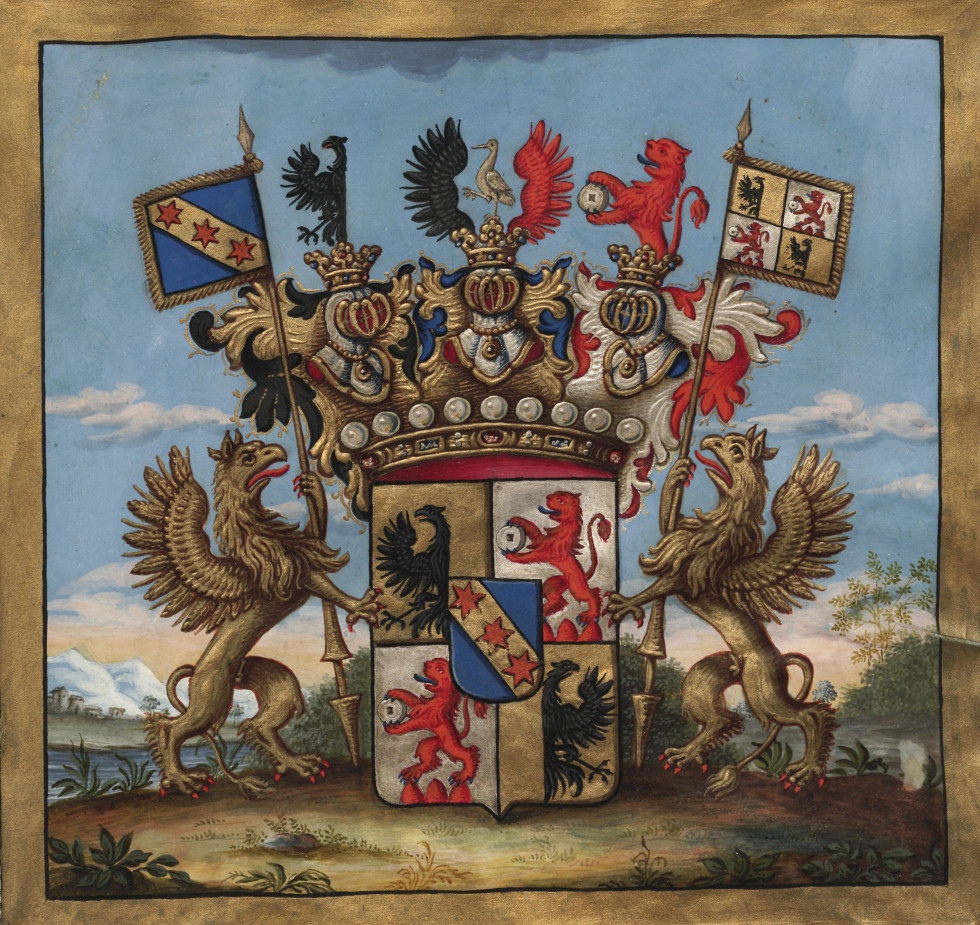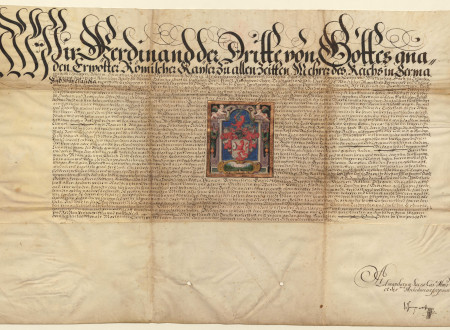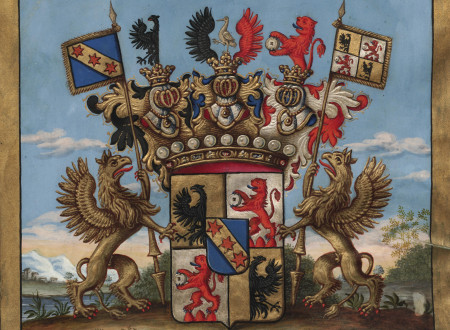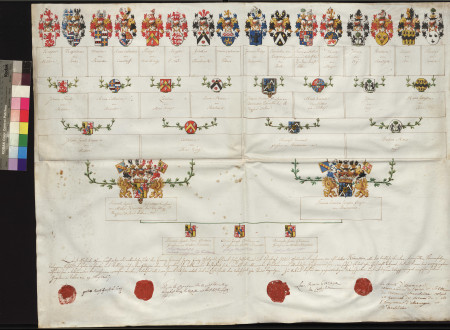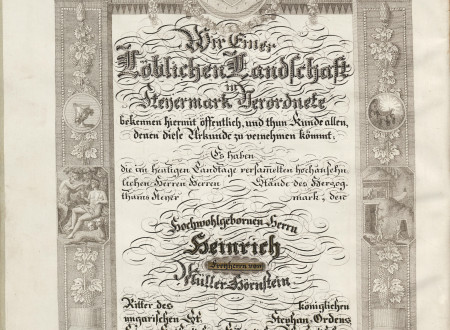Barons Müller-Hörnstein in the Records of the Archives of the Republic of Slovenia
Barons Müller-Hörnstein in the Records of the Archives of the Republic of Slovenia
Article 61 of the Slovenian archival act stipulates that Slovenian archival institutions may acquire their holdings in many different ways, purchase being one of them. In 2018 the Archives of the Republic of Slovenia took the latter option and purchased from Mrs. Rozalija Cigler in Vransko a small, but extremely interesting collection of archival material. Although the collection includes no more than eight pieces – all of them written on parchment and paper - the records themselves actually span over a longer period of time between 1239 and 1831. The purchased material was believed to have been kept at the Vransko Manor and taken from there at the end of World War II, which at the time was more of an exception than the general rule. Since such valuable material rarely becomes available for sale in Slovenia, we were of course very keen to make the purchase.
So far not much is known about the Müller family, which was later granted the baronial title of Müller-Hörnstein. Judging from a short and undated document in the collection, the family is believed to have originated in Tyrol and its family members to have moved to Brussels in 1588, when the Netherlands were ceded to the Austrian House of Habsburg. Members of the family are believed to have been very active in imperial service, for which they were eventually rewarded with a much desired climb up the social ladder and the bestowing of the baronial title in 1794. They were successful merchants, soldiers, some of them also high ranking clerks in the Austrian Netherlands. While life and trade led some of them to France, Tyrol, Bohemia and to other European cities, one family branch found its new home in Styria.
Let us now take a closer look at some of the members of the Tyrolean branch of the family. The earliest mentioning refers to the brothers Rupert and Adam Müller. The former was a gardener of the Austrian Archduke Ferdinand of Tyrol (1564-1595) at the Ambras castle, and the latter was a chamber horse messenger in Upper Austria. On March 31, 1588, the appointed Archduke awarded both brothers with a coat-of-arms diploma which was later destroyed in a fire that broke out at the Ruelust princely residence. In 1637 Ferdinand III of Habsburg (1637-1657) and Claudia de Medici (1604-1648), the wife of his late cousin Leopold V of Habsburg (1586-1632) and the legal guardian Leopold’s heirs, conferred a second coat-of-arms diploma upon Rupert’s son Andreas Michael Müller, a court gardener (Hof- vnd Lustgarttner), and upon all of his legal offspring.
The record most revealing about what we so far know about the Müller family members is a charter written as a proof of ancestry (the so-called Ahnenprobe). It was written in Vienna in 1806 for the three brothers: Henrik Ignaz (*1781), Edward Joseph (*1784) and Christoph Julius (*1785). This charter is presented here as this month’s archivalia. All three brothers were born in Brussels to father Henrik Ignaz von Müller and mother Theresia Eleonora the Baroness of Bartenstein, who married in 1779. The parents had since 1800 been the owners of the seigniories of Starbemberg-Piesting and Hörnstein. The charter brings data for the four male descendants of the Müller family and for their wives. Caspar von Müller is mentioned as the eldest of the four men. He was married to Magdalena von Bode. The family tree continues with his son Johann Franz von Müller, who married Anna Catharina von Rumotto, and Johann’s son Johann Ignaz von Müller, who married Catharina von Mac-Neny. The last in line is the above mentioned Henrik Ignaz. It is interesting to note that one of the people who authenticated the charter was Klemens Wenzel von Metternich-Winneburg, who later went on to become the minister of the interior and the chancellor of the Austrian Empire (1821-1848) and was at the time of the issuing of the charter working as the Austrian ambassador at the French court.
The most important member of the family, however, is the already mentioned Henrik Ignaz von Müller, who is also the person most deserving for the bestowing of the noble title upon his family. Taking up his imperial post in 1772, Henrik earned his fortune through trade with the imperial army. Over the years he acquired the title of the state councillor, did a number of important jobs, especially in financial field, and in 1792 took up the post of the state and war minister in the Netherlands (Notre Conseiller d'Etat, et Secretaire d'Etat et de Guerre actuel pour Notre Gouvernement Général des Pays-Bas). For his loyal service and his war efforts, as well as for the more than 200-year long service to the crown of his family predecessors, all of which is described in detail in the nobility diploma, Franz II of Habsburg-Lothringen, the last Emperor of the Holy Roman Empire, awarded Henrik with a nobility diploma, written in French and wrapped in red velvet covers on May 14, 1794 in Brussels. By means of this document Henrik was raised to the rank of State Barons, and the noble title was to be inherited also by all of his legal offspring, regardless of their gender. Simultaneously with the granting of the baronial title, the Emperor also improved the family’s coat of arms, which from that time on carried the image of the baronial crown with nine pearls.
The exact date of Henrik Ignaz’s death is yet unknown. He was succeeded by his son of the same name, who, like his father before him, was also held in high esteem. The young Henrik was the knight of the Royal Hungarian Order of St. Stephen, the imperial apostolic chamberlain, the court and state councillor at the former Dutch court office in Vienna, and the owner of the seigniories of Reitenau and Aichberg in Styria. In 1831 he purchased the Aichberg castle north-east of Graz. That same year he and his heirs, irrespective of their gender, became inhabitants of the Duchy of Styria, and his male successors also became members of the Styrian land estates. Henrik died in 1843 and after his death his heirs started to gradually sell of the family estate and disperse across the territory of the monarchy. Some of them also settled in Vransko surrounding area, where the Baron Müller acted as the district governor.
The earliest document kept in the purchased collection is the 1236 parchment charter, written in Latin with two, unfortunately lost, wax seals, attached by red and yellow silk woven cord. Although we are familiar with the content of the charter, we have yet to find out when and how it came into the possession of the family. The charter was commissioned by the Augustinian monastery of St. Martin in Yper in Flanders (sancti Martini zu Ypra). It confirms that Adam Arbor from Yper (Adam Arbor bureensis de Ypra) donated two marks in money and land for the abbey and the nunnery of St. Mary de Busco near Yper (beate Marie de Busco iuxta Ypram).
Jure Volčjak


